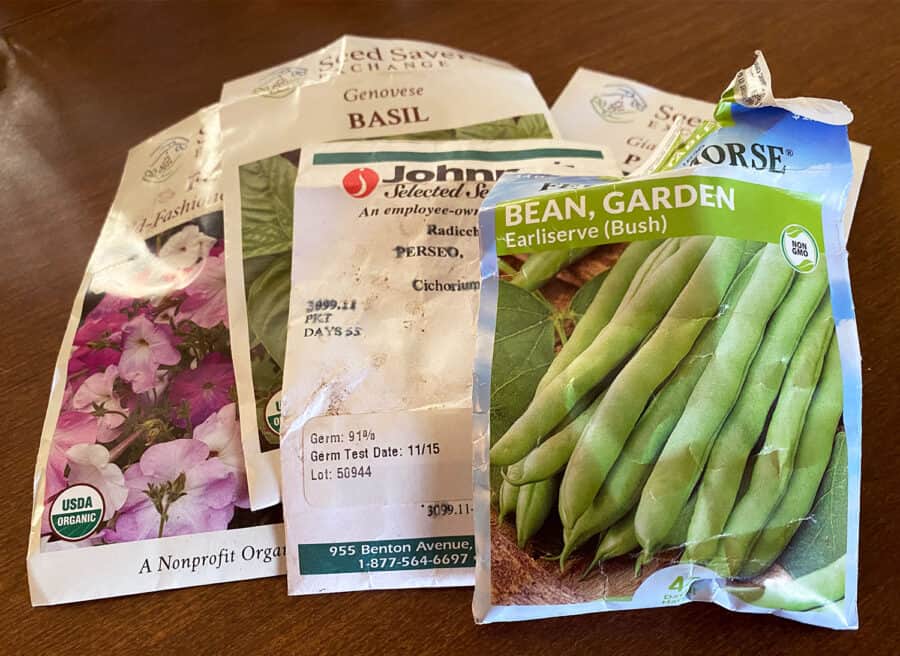When you discover a packet of garden seeds you forgot about, or if you’re wondering if those tomato seeds you bought 6 years ago are okay to plant, you can use this simple test to determine if they’re still viable.

How long are seeds viable?
Seed viability is the measure of the number of seeds that are alive and can produce plants. This applies to any kind of seed: fruit, flower, vegetable, grass, herbs. Some seeds – tomatoes and broccoli for instance – can last up to 5 years if stored correctly. On the other hand, parsley and onion may only be viable for 1 or 2 years under the best conditions.
To learn how old the seeds are, check the seed packet: There should be a date stamped on it somewhere to show which season it was prepared for. Depending on the seed supplier, this may be really obvious or in small print on the backside or flap. Different varieties of seeds can be stored longer than others. Please see our post on how long you can save garden seeds for more details.
How to test seed viability
Seed testing supplies:
- 10 seeds of each variety of each plant
- Paper towels
- Water
- Resealable plastic bag
- Permanent ink marker
Use the steps below for each variety of seed you want to test. Only include 1 type and variety of seed in each paper towel and bag – do not mix different kinds of garden seeds.
- Dampen the paper towel. Do not soak it or the seeds will rot. If the paper towel is the thin kind and starts to fall apart, add a second layer.
- Lay 10 seeds from the packet in question on the damp paper towel.
- Gently fold the damp paper towel around the seeds, making sure the towel contacts the seeds on top and bottom.
- With the permanent marker, write today’s date on the plastic bag, as well as the type and variety of seed you’re testing.
- Place the folded paper towel in the plastic bag and seal it so the towel won’t dry out.
- Place the bag in a warm area that’s consistently above 70 degrees F. For most seeds, direct sunlight is not necessary for germination, just a warm temp.
- Check the paper towel in the bag each day and make sure it hasn’t dried out. It should stay damp if the bag stays sealed. But if you find that the towel is on the dry side, use a spray bottle to dampen the towel.
- After 7 days, check for germination. Remove the damp paper towel from the bag and gently unroll it. You may already see tiny roots emerging from the seeds, but fold up the paper towel again, dampen it, and place it back in the plastic bag. Seal the bag.
- Each seed variety may take a different number of days to fully germinate, so keep checking for up to 2 weeks. After 10-14 days, remove the paper bag from the bag and count how many seeds have germinated. This is your germination percentage (3 of 10 = 30%, 5 of 10 = 50%, 7 of 10 = 70%, and so on). This is the percentage of seeds from this packet you can expect to germinate in your garden.
What is a good germination percentage of seeds?
If your test germination rate is below 70%, you might want to think about buying fresh seed stock. If it’s late in the season and that’s not a possibility, take a shot: sow all of the seeds in your garden, or start the seeds in pots indoors, 4-6 in each pot. After the current year, buy new seeds for next season or save the seeds from this year’s garden.
Can you plant the seeds that germinated in the paper towel?
Yes, you can. In order to not damage the delicate roots, cut the paper towel in pieces – one for each germinated seed. Plant the seed in the towel directly in your garden – the towel will deteriorate throughout the season and will help to hold water near the seedling’s roots. Don’t include more of the towel than is necessary at planting time.
How to test larger seeds like peas and beans
Peas, beans, and corn can be quickly tested in a bowl of water. Viable seeds will sink, dead seeds will float. Plant any seeds that sank immediately.
Sources: North Carolina State University, Extension University of Illinois Extension
